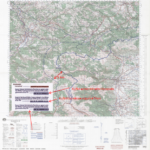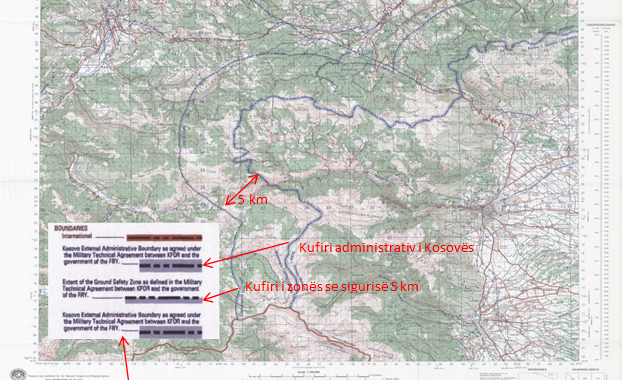One of the main issues after the war is the aspect of citizen security and border security. In accordance with Resolution 1244 and the Kumanovo Military Technical Agreement in Kosovo are placed international security forces, KFOR, which have a duty to provide a safe mandate to all citizens of Kosovo and the same time to control and supervise Kosovo’s borders and allow space for the establishment of international organizations in Kosovo.
In accordance with this agreement, there were also certain areas of safety, air security zone and The Ground Safety Zone. Point (d) states, air safety zone is defined as an area of 25 kilometres and spans from the Kosovo outer border inside Federal Republic of Yugoslavia, namely Serbia and Montenegro.
Ground Safety Zone is defined as an area of 5 km, which spans from the outer border of Kosovo inside Federal Republic of Yugoslavia, namely Serbia and Montenegro.
Military technical agreement, 03 July 1999
It was reached between NATO and FR Yugoslavia to terminate _ bombardment from NATO on 24 March 1999 and ended after 78 days on 09 June 1999. According to the Ahtisaari Plan, and mapping document delivered that Serbia, namely FRY should withdraw from territory of Kosovo.
Here is the question which was the territory of Kosovo?
The answer is in the Ahtisaari document exactly in the military technical agreement 03 June 1999. Description of the territory of the Province of Kosovo and the map attached to this agreement is in full compliance with the administrative line of the Province of Kosovo and implemented since 1974 until today August 2016. On the basis of this map is made establishing of international security force KFOR. From the military technical agreement of 03 June 1999, following several paragraphs are highlighted for the best clarity for the reader.
“Military technical agreement, 03 July 1999
Between the International Security Force (“KFOR”) and the Government of the Federal Republic of Yugoslavia and the Republic of Serbia Article 1: General Obligations
The Parties hereby reaffirm the document presented by President Ahtisaari to President Milosevic and approved by the Serbian Parliament and the Federal Government on 3 June 1999, to include placing Kosovo under the auspices of the UN an effective presence of civil and international security. The parties further point out that the Security Council has prepared to adopt a resolution ………. “on the matter. The full document can be downloaded from the following web site: Military-Technical Agreement between the International Security Force and the Governments of the Federal Republic of Yugoslavia and the Republic of Serbia, signed in Kumanovo on 9 June 1999, available at www.nato.int/kosovo/docu/a990609a.htm .
Article 1: General Obligations of the agreement are written in paragraph (e). “Ground Safety Zone (GSZ) is defined as a 5-kilometer zone that extends beyond the territory of Kosovo, inside the rest of the territory of the FRY. This area includes the terrain within that 5 kilometres “. The territory of the Province of Kosovo was known then and now and KFOR map is in full compliance with the border between the Province of Kosovo and the Republic of Montenegro.
• Air Safety Zone is defined as an area of 25 km, which spans from the outer boundary of Kosovo, inside the territory of the Federal Republic of Yugoslavia.
• Ground Safety Zone is defined as an area of 5 km which spans from the outer border of Kosovo inside territory of Federal Republic of Yugoslavia.
• On 09 June 1999, paragraph 1 point (e) clearly says: By EIF +11 days, all FRY forces in Kosovo will have completed their withdrawal from Kosovo (map attached as Annex A to this Agreement) in Serbia outside Kosovo and not within 5 km of the ground safety Zone (GSZ).
This shows that the map and the agreement is in full compliance without changing the administrative line 1974-1988-1999 – 2008 and the border marked by the State Commission and signed in Vienna.
On 10 June 1999, the Security Council adopted resolution 1244 (1999), based on the G-8 agreed principles under Chapter VII authorizing placing Kosovo under the auspices of the UN, placing of an international civilian presence – Mission for Provisional administration of the United Nations in Kosovo (UNMIK),
See the following from the website: United Nations Security Council resolution 1244 of 10 June 1999, available at www.un.org/Docs/scres/1999/sc99.htm
Chronology of Kosovo’s freedom www.un.org/Docs/scres/1999/sc99.htm until placement of UNMIK:
– – 3 June 1999 approval of the agreement of NATO with FRY Security Force
– – June 5 representatives of NATO and Yugoslav Government finalized the details on the preparation of a military-technical agreement.
– – June 8 G-8 Foreign Ministers, at a meeting held in Cologne, reached an agreement on a draft resolution on Kosovo for the Security Council of the UN and EU Special Representative, the envoy Ahtisaari met with Chinese President and Chinese foreign minister in Beijing.
– – 9 June 1999, after 78 days of the air campaign and under pressure from Russia, Serbia accepted the terms of the ceasefire and the military-technical agreement is signed
– 10 June 1999, Security Council of UN approves resolution 1244.
Documents approved have the full power and are absolutely mandatory for Kosovo because the agreement and the map in this period on the table of decision makers. The text of the agreement is cited and map attached below. United Nations Security Council resolution 1244 of 10 June 1999, available at www.un.org/Docs/scres/1999/sc99.htm. Included as Annex 1 to United Nations Security Council resolution 1244, op.cit.
Forces of the Federal Republic of Yugoslavia will not enter, will not enter again, and will not stay in the territory of Kosovo without the consent of the commander of the international security force KFOR. KFOR has controlled and supervised the border Kosovo – Montenegro, in accordance with the Military Technical Agreement, and the annex to this Agreement maps (map attached).
The map of 09 June 1999 presented of Kosovo border and a buffer zone of 5km.
When states will not enter the territory of Kosovo, or KFOR has controlled and supervised the border means that that line and that _ territory is define on the map of NATO / KFOR, which is fully compatible with the administrative line 1974-1988-1999 -2008 and 2016.
While the authorities of Montenegro, did not have access to this area of 5 km within the territory of Montenegro, during this time the citizens of Kosovo, have entered, stayed and moved in the area, without being obstructed by the authorities of Montenegro. Citizens of Kosovo, also used this area for pasture. Some of them also have developed several businesses, fuel pumps improvised, smuggling cigarettes and coffee.
In 2004 was taken an action of KFOR and Kosovo police where were removed from this area the citizens. Improvised businesses are removed, was seized a quantity of petroleum, coffee and cigarettes, pipes were removed with which has been smuggled fuel to the village of Novo Selo.
Kosovo Police Powers
Initially, after the war in Kosovo, KFOR has _ been the only authority for the control and supervision of Kosovo’s borders. With the establishment of the Kosovo Police Service, now the Kosovo Police, with building and developing of its capacities, it has begun to control and monitor the borders of Kosovo, together with KFOR, through joint patrols. The border, the one since the year 1974-1988 to date, in August 2016 with Montenegro, Kosovo Police, has begun to control and supervise together with KFOR since 2001. For this is submitted the map of Ahtisaari agreement attached to this article.
With the creation of the legal infrastructure for Borders, Law on Control and Oversight of the borders and the promotion of cooperation with border police of neighbouring countries and the signing of agreements on police co-operation, KFOR, after removing the safety zone / air zone and ground security in 2008, started the transfer of competencies for border control and supervision to the Kosovo Police. This transfer of responsibilities is done by agreement between KFOR and the Government of Kosovo and EULEX, as they estimated capacity of human and technical aspect of Kosovo Police, to take these responsibilities, in the agreement is implemented border / boundary under KFOR military Technical Agreement:
• 03 September 2011 KFOR handed over to Kosovo Police the control and supervision of the border with Montenegro.
Kosovo Police today has protocols for joint patrolling with border police of neighbouring countries: Albania, Macedonia and Montenegro. These borders are patrolled jointly by the authorities of the respective states.
Kosovo police controls and monitors the border between Kosovo / Montenegro, border / boundary line which is submitted from KFOR to the Kosovo Police, in accordance with Resolution 1244, the Military Technical Agreement of 09 June 1999 (appendix of maps), border which is defined by the Constitution of 1974, the Ahtisaari plan, which plan was approved by the Assembly and through which is announced independence of Kosovo, and with these borders, Kosovo has been recognized by the countries of the world.
Agreement on local border traffic
Kosovo has signed with Montenegro, the Agreement on local border traffic. Local border traffic is crossing the border by border residents in order to stay in the border area of the parties for social, cultural, sports, educational, economic, family, religious, or other legitimate reasons.
This agreement allows citizens of the respective countries, to cross the border Kosovo – Montenegro outside border crossing points, in the most suitable places for them. To stay, move and exercise activities, in their respective territories. This movement, stay, grasses extends to 30 km from the border line inside the respective territories.
Last modified: July 31, 2022

